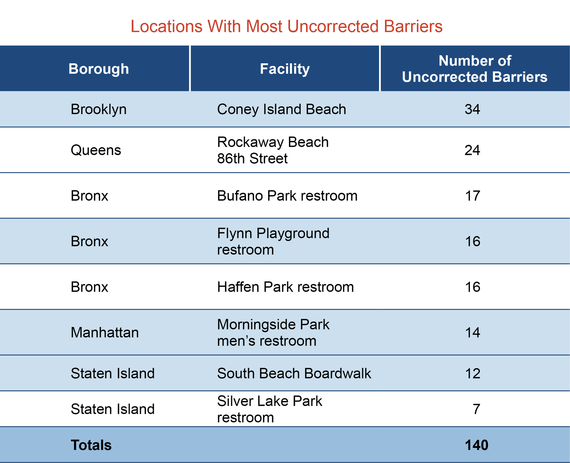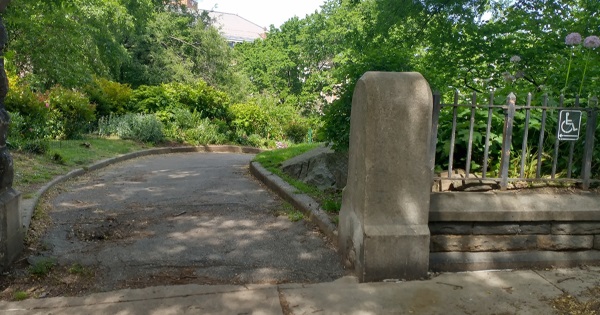More than 30 years after the Americans with Disabilities Act (ADA) prohibited discrimination on the basis of a disability, too many New York City Parks Department facilities have barriers to people with disabilities and many don’t meet ADA standards, according to an audit by State Comptroller Thomas P. DiNapoli.
“Federal law demands equal access to public spaces, but we found hundreds of barriers to people with disabilities in our city parks, playgrounds and beaches,” DiNapoli said. “The city has made progress over the years, particularly making new projects accessible, but many of the problems we found have existed for years and should have been addressed long ago.”
Nearly two decades ago, in December 2005, a State Comptroller’s Office audit found that the Parks Department did not identify and address obstacles to accessibility. In response, Parks surveyed 2,745 facilities and found accessibility issues at more than 2,000 of them. It ranked the problems it found in a prioritization plan, ranging from Readily Achievable (Priority Level 1), which includes adding signs, armrests or parking spaces, to Not Achievable (Priority Level 5) for historic sites or hilltop parks where a fix was not feasible. Most of the barriers were Readily Achievable. The survey was supposed to be the basis of an accessibility Transition Plan, a requirement for public entities under the ADA, but the Plan was never finalized.
In the audit released today, DiNapoli’s auditors found that while Parks has made progress in increasing accessibility for New Yorkers, it has focused on making sure newly funded projects are ADA compliant, over removing barriers at existing facilities. Auditors visited 115 facilities at 22 properties and found hundreds of the same accessibility problems first catalogued. Auditors observed 297 Priority 1 or 2 barriers from the Parks survey at these facilities and found that 64% remain uncorrected.
Examples of uncorrected barriers include:
- Inaccessible bathroom entrances, playgrounds, drinking fountains and a spray shower at Staten Island’s Clove Lake Park.
- An inaccessible service desk, weight room and lockers at the J. Hood Wright Park’s Recreation Center in Manhattan.
DiNapoli’s audit listed facilities with the most uncorrected barriers that were ranked either Readily Achievable or Achievable (Priority 2).
The audit found another 309 accessibility barriers that were not in Parks’ original survey, including:
- Bathroom stall doors at newly renovated playgrounds narrower than the ADA standard of 36 inches.
- Designated accessible entrance ramps steeper than ADA guidelines, potentially creating safety risks. At Morningside Park in Manhattan, a designated wheelchair ramp was three times steeper than the allowable standard, had no handrails and was potholed (see picture below).
Many of the 309 barriers were similar to what Parks ranked identified as Priority 1 barriers that could be corrected without much difficulty or expense. The most common problems were a lack of signage, problematic access routes, sinks, ramps, playground entrances and bathroom stall doors.
DiNapoli’s audit also found that:
- Parks created an ADA coordinator position after the original audit, but the individual’s oversight is limited as the coordinator does not sign off on new construction or renovations at the design or completion phase.
- Parks officials did not properly watch over concession contractors to make sure they were living up to their contract requirements to meet ADA accessibility guidelines, including ramps that were too steep and bathroom stalls with no grab bars.
- Accessibility information on Parks’ website was not always accurate and was contradicted by auditors’ observations at 22 properties.
- Accessibility is not a performance indicator in the Mayor’s Management Reports (MMR) for Parks, which could help prioritize the goal of ensuring all New Yorkers’ equal access to facilities.
Recommendations
The audit recommended that Parks:
- Review and update its accessibility survey, review the barriers identified in the audit, and begin to address barriers that can be fixed without much difficulty or expense.
- Complete the Transition Plan and monitor its implementation.
- Make sure the facilities accessibility information on its website is accurate.
- Prioritize accessibility work as a goal and a performance indicator.
- Engage with the Mayor’s Office to include accessibility in the MMR.
While Parks agreed with a number of the audit’s recommendations, it did disagree with several findings including the use of Priority levels from its earlier survey, stating that “What was ‘readily achievable’ in 2006 may not be ‘readily achievable’ now, due to differences in the Mayoral administration, funding priorities, and staff.”
Report
NYC Dept. of Parks & Recreation: Park Accessibility for People With Disabilities
NYC Dept. of Parks & Recreation: Compliance with ADA Requirements (2005)
Track state and local government spending at Open Book New York. Under State Comptroller DiNapoli’s open data initiative, search millions of state and local government financial records, track state contracts, and find commonly requested data.


